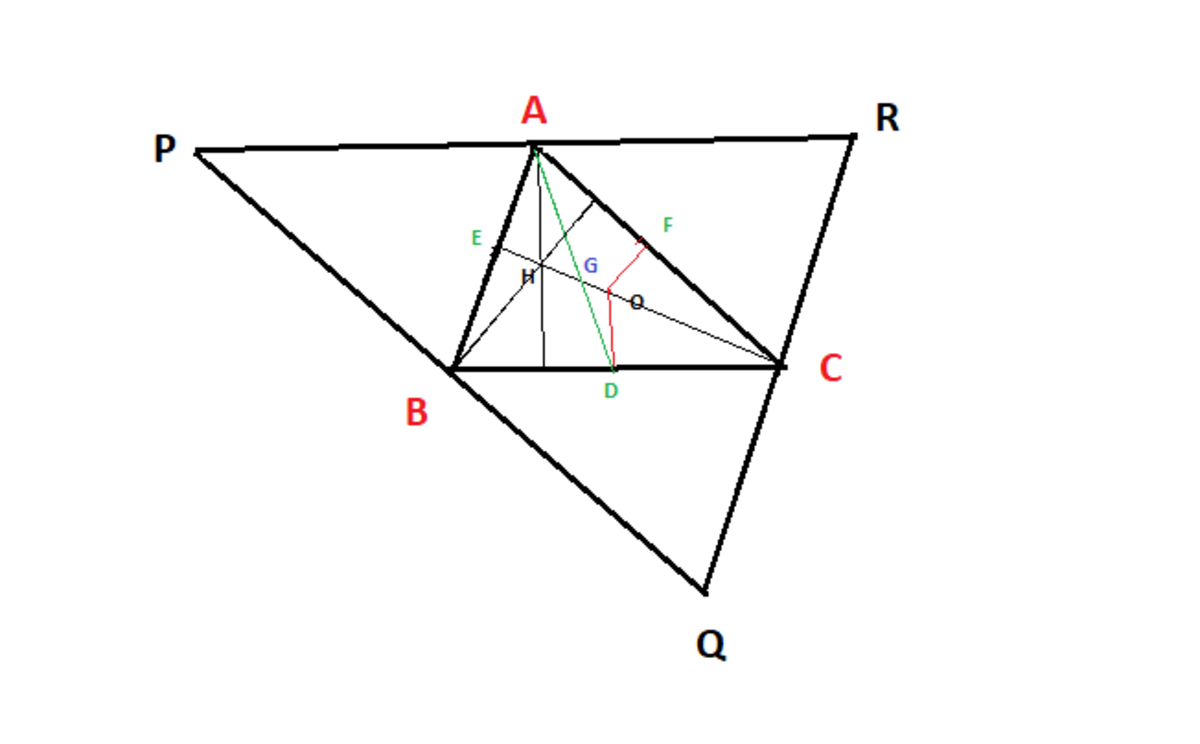Problem of Sylvester
The circumcenter of △ A B C is O , and the orthocenter of △ A B C is H .
Find the value of m so that O H = m ( O A + O B + O C ) .
Details and assumptions:
- The orthocenter of △ A B C is the point at which the altitudes of △ A B C intersect.
- The circumcenter of △ A B C is the point which is equidistant from A , B and C .
The answer is 1.
This section requires Javascript.
You are seeing this because something didn't load right. We suggest you, (a) try
refreshing the page, (b) enabling javascript if it is disabled on your browser and,
finally, (c)
loading the
non-javascript version of this page
. We're sorry about the hassle.
2 solutions
We know if the centroid of the triangle
Δ
A
B
C
is
G
, then
O
H
=
3
O
G
. Now we know that
O
G
=
3
1
(
O
A
+
O
B
+
O
C
)
. Combining these we get
m
=
3
3
=
1
.

In this Δ A B C the points H , O , G are the Orthocenter, Circumcenter and Centroid respectively. Draw Δ P Q R .Let it be the tringle twice of Δ A B C and inverted such that A B ∣ ∣ Q R ; A C ∣ ∣ P Q and B C ∣ ∣ P R . And P A = A R ; P B = B Q ; Q C = C R . Thus, H becomes the circumcenter of Δ P Q R as well as the orthocenter of Δ A B C . From the symmetry we can conclude that A H = 2 D O .
Let, the line A D intersects O H at G . As, A H ∣ ∣ O D and A H = 2 D O , we can say from the two symmetric triangles Δ A H G and Δ O G D that A G = 2 G D . So, G divides the line A D in 2 : 1 ratio and D is the mid point of B C . So, its certain that G is the centroid of Δ A B C , G lies on the line O H and also H G = 2 G O .So, O H = 3 O G .
In fact, the fact O H = 3 O G is actually derived from this problem's result. If you can find other ways to prove O H = 3 O G without using this the proved result, then I'm very appreciated at the solution.
I had proved the result that O , H , G are colinear and proved O H = 3 O G by pure geometry by myself. I shall upload the proof.
Log in to reply
OK, thanks!
Log in to reply
I have updated my solution with the proof of my conclusion. This is the proof what I had found.
If we write a = O A , b = O B , c = O C , then ∣ a ∣ = ∣ b ∣ = ∣ c ∣ = R where R is the outradius, and hence ( a − b ) ⋅ ( a + b ) = ∣ a ∣ 2 − ∣ b ∣ 2 = 0 Thus a + b is perpendicular to A B , and hence the altitude through C has equation r = c + λ ( a + b ) λ ∈ R Thus the altitude passes through the point with position vector a + b + c . By symmetry, this is true for all the other altitudes, and hence we have identified the orthocentre O H = a + b + c making the answer m = 1 .